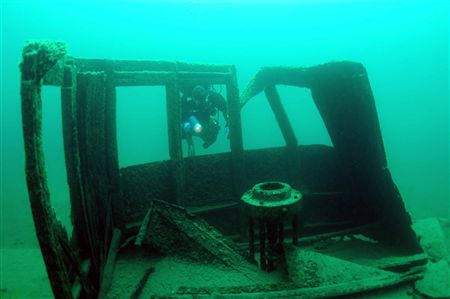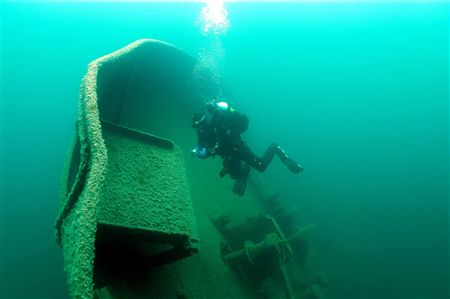Madeira and Hesper Monitoring Project
July 28 - 29, 2012

Madeira Pilot House
Photo by Tamera Tompsen

Madeira Stern
Photo by Tamera Tompson
With this project we will be Monitoring the conditions of each shipwreck through visual observation
drawings and also using both still and video photography.
We will be cruising, sleeping, eating and diving from the R/V Preservation for this Project.
NOTE: The $20.00 charge for the project is for the split costs of food for the project. The main project is FREE!
SPECIAL NOTE:
The Visibility has changed substantially since the flooding occurred at
the end of June. Please stay tuned to the GLSPS website and or watch
for any additional emails if you registered for this project.
The Madeira and Hesper have been underwater for a very
long time. Mother nature has done a great job preserving them but she
has also taken a toll on them as well. As divers we dive on these
shipwrecks and will eventually cause wear from divers diving them year
after year.
This is were the GLSPS comes into play. With the joint
effort of the Minnesota Historical Society (MHS) and the Department of
Natural Resources (DNR) the GLSPS tries to help stabilize and preserve
these shipwrecks from further deterioration. We work closely with the
MHS, DNR and sometimes the Cities that are near these shipwrecks, to
gain access through special permitting to perform the underwater work we
do to preserve the shipwrecks.
Before we can do any of this, we need to document and
Monitor each shipwrecks deterioration characteristics. We then will
write a proposal / plan as to how we are going to do this. We present
it to the GLSPS Board of Directors. If the Board approves the plan, we go to work and
implement the plan to the DNR MHS to obtain a permit to work on the shipwreck to help preserve it for years to come and
for future divers to be able to see close to what we saw when we first
dived the shipwreck.
If you are interested in this project, would like to learn more and register, please click on the provided link below.
Madeira And Hesper Monitoring Project
Please note: All project participants are required to print, read and sign the GLSPS "Liability and Waiver Forms". Please don't forget to bring the forms with you to the project. Please
remember, if you answer "NO" to all the Medical form questions, you do
not have to fill out the second page of the Medical Form. If you answer
"Yes" to any of them, you will need to have a Physician OK you to dive
with the GLSPS.
Master Liability and Waiver Forms
Aquaventure Dive and Photo Center is providing a
Go Pro HD Underwater Camera for the GLSPS to use to help monitor these
shipwrecks. Thank you Steve and Jolene Philbrook for allowing us to
use the piece of equipment. To inquire about a Go Pro HD video camera
for yourself, please give Steve a call at the dive shop. If you would
like to learn more about Aquaventure Dive and Photo Center, please click on the logo provided on left side bar of this website.
Here is your chance to dive the Madeira and Hesper aboard the R/V Preservation and have fun with a little research as well!
I will see you on the Project.
Corey Daniel
Project Leader
________________________________________________________________________
Madeira and Hesper Monitoring Project
July 28 - 29, 2012
Closing Report
Madeira/Hesper Monitoring Project 2012 photos
The Plan we followed for the Madeira and Hesper Monitoring Project:
Friday Night:
* Most divers met at the Dock at Silver Bay Marina and slept on the boat.
Saturday:
1. 7:00 AM Wake up call, had breakfast, performed boat briefing and proceed South to the Madeira dive site.
2. 9:00 AM - Performed dive and safety briefing, establish dive buddies
and dive teams one and two. Then prepared for the the first dive with Dive Team One and Brief them on what to monitor and document
(with cameras and slates) on the Madeira of any deterioration on the
shipwreck.or to the Dive Site.
3. 9:30 Prepared and Sent Dive Team Two for first dive.
4. 10:00 AM - Started filling tanks after dive team one returned.
5. 11:00 AM - Prepared for Second Dive for dive team when surface interval was adequate and the first teams tanks are filled.
6. 12:00 to 1:00 PM - Served lunch. Started filling tanks for dive team two.
7. 1:30 PM - Prepared for the second dive for the second dive team to finalize the Monitoring.
8. 3:00 PM - After the second dive team returned, we proceed North back to Silver Bay Marina after nice pass of Splitrock Light house. Filled the remainder of the tanks while returning
to the Marina.Dinner was enjoyed at the Scenic 61 restaurant in Beaver Bay. Most slept on the boat.
Note: Marina does not allow compressors and generators to run at the Marina!
Sunday:
1. 7:00 AM - Wake up call. Prepared breakfast and proceed to the Madeira Dive Site.
2. 8:00 AM - Performed Dive and Safety Briefing. Prepared first dive for
Dive Team One and (the deepest dive) briefed them on what to Monitor and Document (with
camera's and slates) of any further deterioration on the
shipwreck. Noting any dive site damage in general.
3. 9:00 AM - Prepared and sent Second Dive Team for first dive. Started filling tanks for dive team one.
3. 11:00 AM - Prepared for Second dive if surface interval has been adequate. Start filling tanks for Dive Team Two.
4. 12:00 - 1:00 PM - Served lunch as dive teams return from dive.
5. 1:00 PM - Cruised North to Hesper dive site.
6. 2:00 PM - Dive team one proceeded with dive
7. 3:00 PM - Dive team two proceeded with their dive
8. 4:30PM- Returned to Silver Bay Marina to drop off divers. Project debriefing commenced.
9. This concludes our Madeira and Hesper Monitoring Project. We have much monitoring data to sort through to produce a report on
how they are deteriorating. The report will eventually find it's way to
this section of the GLSPS Website for members to view. Please watch for it on the
website.
Further details about are as follows.
1. The Hesper dive indicated that the wreck is relatively stable. Knees and other structure seem to move around very little and as far as the difference between years past and this monitoring project. We did note that the bilge pump that was put back on the wreck a few years ago was tipped over so we up-righted it to the standing position where it is supposed to be.
Note: Check out this video of the Hesper filmed by Sarah Korthauer
Madeira Monitoring:
1. Three dives were performed by two different teams, covering the majority of the wreck. The pilot house is still standing and deteriorating slowly as noticed last year. Moving towards the smokestack-- a piece of structure 3-4 feet wide broke off just before the stack. Appears rivets rusted away and the piece fell over. Noticed this occurring on the stern port side. Rivets rusting away, hull plates shifting and rivets popping out. You can sometimes find the rivets on the lake bottom. While inside the stern the holes can be observed with the ambient light outside the hull shining thru. Overall, the wreck hasn't changed significantly. I want to make some key measurements on the stern section next year to determine if the port side of the hull is gradually collapsing and at what rate. I enjoy taking new divers on this wreck and showing them parts of the wreck that most don't usually see.
My goal is to get the divers participating in this project more familiar with all of the wreck to give more insight to observed changes. I also would like to document the mid section better and correct placement of pieces along the hillside.
Thank you again to everyone who participated in the project, everyone's help and input was appreciated.
We hope to see you on the next project.
Corey Daniel
Project Leader
heygadgetman@yahoo.com
Cell - 218-343-4970